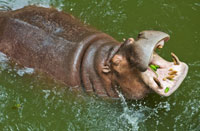The South African National Parks (SANParks) said in a statement that the anthrax outbreak that started in late August in the north of the Kruger National Park has claimed the lives of 30 hippopotamus in the Letaba and Olifants Rivers in the past two weeks. Post mortems results from some of the carcases suggest they were infected by the bacteria.
Reynold Thakhuli, spokesman for SANParks said a total of 30 hippo carcases have been found up to now and park rangers are closely monitoring the situation. "Members of the public are urged to report any sightings to the nearest camp and not to touch the carcases. The state veterinarians are busy examining six carcases and will issue the results as soon as they are available."
Anthrax is a highly infectious disease of animals caused by the bacterium Bacillus anthracis. "It is thought that the disease is spread mainly through vultures and blowflies. Vultures are immune against anthrax and they spread the disease by consuming contaminated meat from affected carcasses and then defecating in water bodies where they regularly drink or bath. The toxins released by the bacteria when it sporulates are also fatal to some species," Thakuli said.
Linked to population density
Anthrax outbreaks are a natural occurrence in the northern areas of the Kruger National Park and occur more or less every ten years, apparently related to the end of dry cycles. It usually occurs during the dry months of the year.
It is also closely linked to population density - when certain species like kudu and hippo reach high densities then anthrax spreads more rapidly. The disease is also the only disease in KNP that needs to kill its host in order to propagate itself. In all the outbreaks before the disease naturally dissipates when the rains start and when animal densities decrease; so it can be considered a natural regulator of animal densities. The current outbreak has seen relatively low numbers of cases in relation to population sizes of species affected.
During the previous outbreak of 2010 in the Nxanatseni region it is estimated that approximately 2 000 animals died. "The Kruger National Park rangers are currently monitoring the situation on a daily basis to determine if they are more carcasses in the rivers," Thakhuli concluded.







































